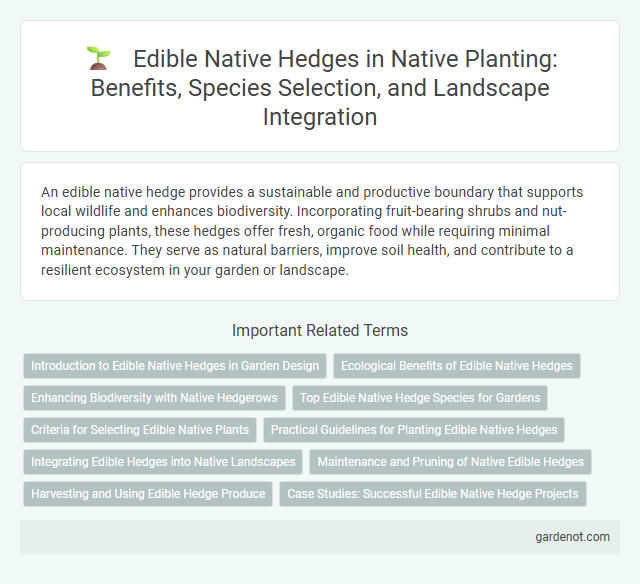An edible native hedge provides a sustainable and productive boundary that supports local wildlife and enhances biodiversity. Incorporating fruit-bearing shrubs and nut-producing plants, these hedges offer fresh, organic food while requiring minimal maintenance. They serve as natural barriers, improve soil health, and contribute to a resilient ecosystem in your garden or landscape.
Introduction to Edible Native Hedges in Garden Design
Edible native hedges combine functionality and biodiversity, serving as natural fences that provide fruits, nuts, and berries while supporting local wildlife. Incorporating species like elderberry, serviceberry, and wild grape enhances soil health and offers seasonal harvests, integrating sustainability into garden design. These hedges promote ecological balance, reduce maintenance, and foster a connection to the regional ecosystem through traditional, native plants.
Ecological Benefits of Edible Native Hedges
Edible native hedges provide vital habitats for local wildlife, supporting pollinators, birds, and beneficial insects while promoting biodiversity. These hedges improve soil health through natural nitrogen fixation and organic matter accumulation, enhancing ecosystem resilience. Incorporating native edible plants into hedgerows also fosters sustainable food sources that require minimal water and chemical inputs, aligning with ecological conservation goals.
Enhancing Biodiversity with Native Hedgerows
Edible native hedges such as elderberry, serviceberry, and huckleberry provide vital habitat and food sources for pollinators, birds, and small mammals, significantly boosting local biodiversity. These hedgerows support soil health by promoting microbial activity and preventing erosion, while also offering sustainable food options native to the region. Integrating native edible plants into hedgerows creates resilient ecosystems that encourage wildlife diversity and ecological balance.
Top Edible Native Hedge Species for Gardens
Top edible native hedge species for gardens include California lilac (Ceanothus spp.), which produces nutrient-rich berries attractive to pollinators and wildlife. Spicebush (Lindera benzoin) offers aromatic leaves and edible berries, supporting local ecosystems while providing a natural privacy screen. Serviceberry (Amelanchier alnifolia) yields sweet, vitamin-rich fruits, making it an excellent choice for sustainable and productive native hedges.
Criteria for Selecting Edible Native Plants
Selecting edible native plants for hedges requires consideration of local climate adaptability, soil compatibility, and growth habits to ensure sustainable development and minimal maintenance. Preference should be given to species rich in nutrients and with proven yields of edible fruits or leaves, such as elderberry or serviceberry, which also attract pollinators and support biodiversity. Resistance to pests, disease tolerance, and non-invasiveness remain critical factors to maintain ecological balance and long-term hedge health.
Practical Guidelines for Planting Edible Native Hedges
Select native species such as elderberry (Sambucus spp.), serviceberry (Amelanchier spp.), and chokecherry (Prunus virginiana) for edible hedges to ensure adaptability and wildlife support. Plant spacing should be 2-3 feet apart to promote healthy growth and easy harvesting, with preference for well-drained soils and partial to full sunlight. Regular pruning and mulching help maintain plant health, enhance fruit production, and suppress weeds in edible native hedges.
Integrating Edible Hedges into Native Landscapes
Integrating edible native hedges into landscapes enhances biodiversity while providing sustainable food sources such as wild blackberries, serviceberries, and elderberries. These hedges support pollinators and wildlife by offering natural habitats and seasonal fruits rich in vitamins and antioxidants. Selecting region-specific native plants ensures resilience to local climates and soil conditions, promoting ecological balance and reducing maintenance needs.
Maintenance and Pruning of Native Edible Hedges
Maintenance of native edible hedges involves regular monitoring for pests and diseases to ensure healthy growth and optimal fruit production. Pruning should be performed during the dormant season to shape the hedge, encourage new growth, and increase fruit yield, using clean, sharp tools to prevent damage. Proper spacing and mulching around the base help retain moisture and reduce weed competition, promoting a vigorous native edible hedge.
Harvesting and Using Edible Hedge Produce
Harvesting edible native hedge produce requires timing to ensure optimal ripeness, typically during late summer to early autumn when fruits, berries, and nuts reach peak flavor and nutritional value. Use gentle hand-picking techniques to preserve plant health and encourage regrowth for future harvests, while storing produce in cool, dry conditions to extend shelf life. Native edible hedges provide versatile ingredients for jams, sauces, salads, and foraging-based recipes that emphasize natural flavors and seasonal variety.
Case Studies: Successful Edible Native Hedge Projects
Case studies of edible native hedge projects reveal significant ecological and culinary benefits, showcasing species like blueberry (Vaccinium spp.) and elderberry (Sambucus canadensis) thriving in diverse climates. Successful installations in urban and rural settings demonstrate increased biodiversity, improved soil health, and sustainable food sources for local communities. These projects underscore the importance of selecting region-specific native plants to maximize yield and ecosystem resilience.
Edible native hedge Infographic

 gardenot.com
gardenot.com